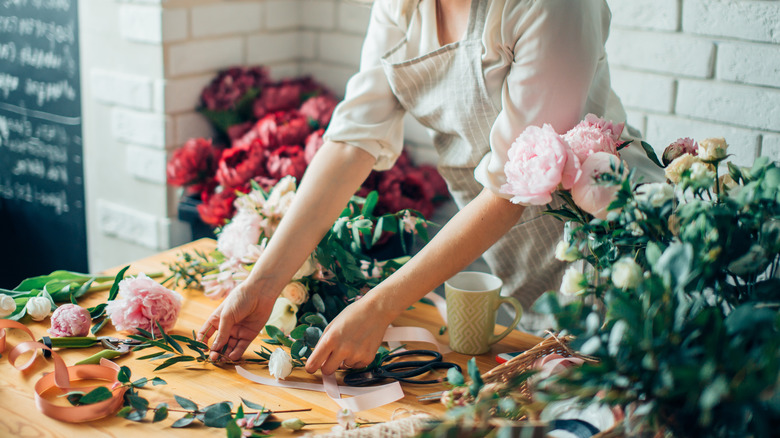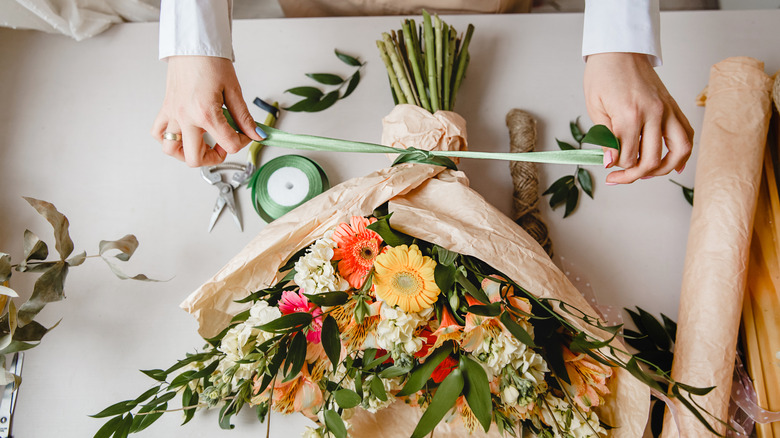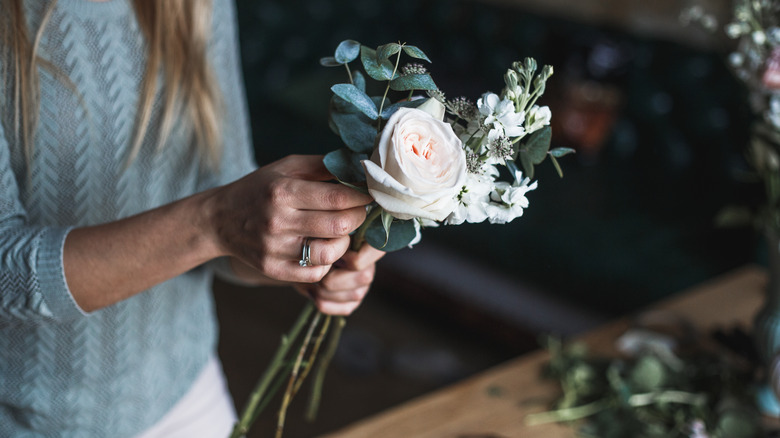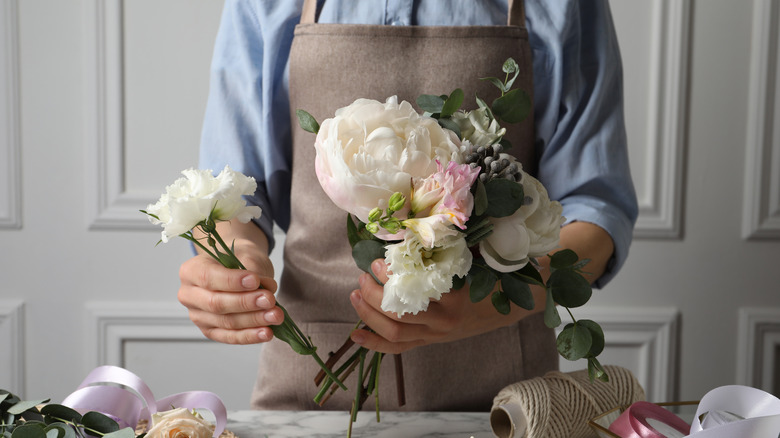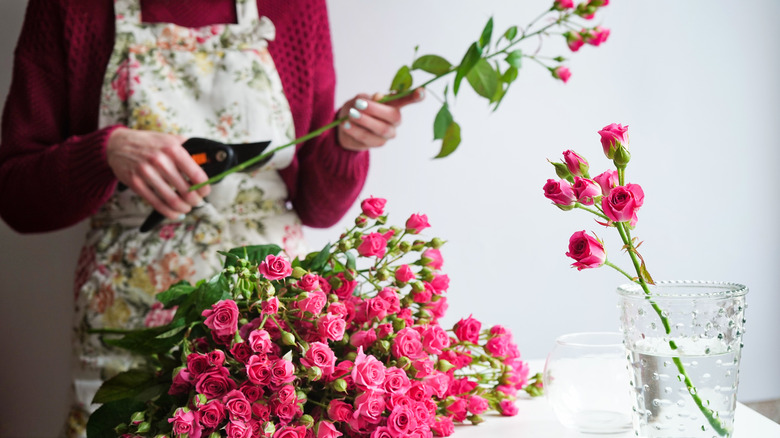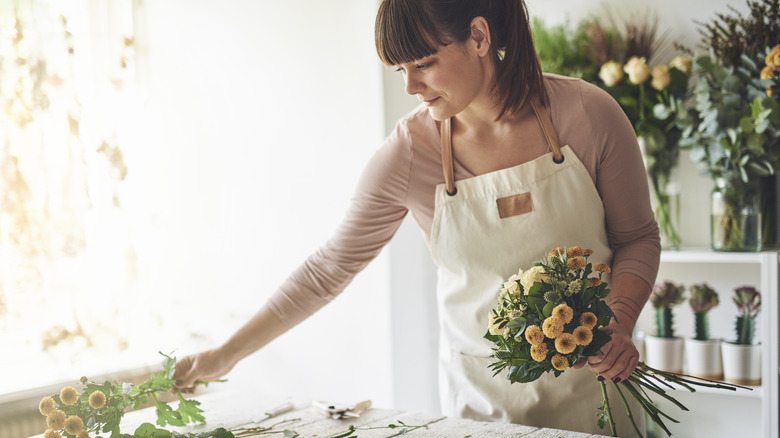How To Arrange Fresh-Cut Flowers Like A Professional Florist
From HGTV to your Instagram feed, fresh-cut floral arrangements have quickly become the hottest new home decor accessory (and activity). According to NBC News, there's been a growing houseplant boom over the years that's consequently overtaken social feeds and our lives. And this year, the trend for fresh and natural home decor seems to be shifting to include farm-fresh flowers stylistically arranged right out of the box. Much like your favorite monstera, these botanical bouquets are a great way to introduce a pop of color to your home, as well as express your personal style in a fun way. They also make a wonderful and thoughtful gift for friends, loved ones, or even that special someone.
And while there's nothing wrong with picking up a pre-made bouquet from the store, there's something extra special about crafting your own unique arrangements from scratch. Luckily, flower arranging is a simple DIY craft that even beginners can pick up rather quickly. Even if you aren't a professional florist, you don't have to break the bank to create a floral centerpiece, either; you can arrange your flowers like a pro and create a stunning display with the right supplies and a few tips from experts.
Gather your supplies
Before you do any arranging, you'll need to purchase some flowers, greenery, and a few additional tools. In addition to a vase, you'll want to grab a floral knife or sharp scissors, some clear floral tape, and a vase (via Floranext). Start by choosing the color palette for your arrangement and choose three primary colors to stick with. This will allow you to keep your vision coherent without overwhelming your design. When adding flowers and greenery to your arrangement, you'll want to choose a variety of bloom sizes to create a more layered look. For a homemade floral arrangement, Blooms by the Box recommends up to 20 to 30 stems of fresh flowers and greenery for a large vase, though smaller vases will require fewer stems.
Still looking to add some spice to your floral arrangement? The recent boom in floral design has made professional-grade floral tools that elevate your bouquets — like a flower frog or even netting to keep the flowers in place — more accessible. However, if that sounds too confusing, there's no need to worry. As floral designer Sierra Steifman tells Martha Stewart Living, "If it's your first time working with flowers, try to keep your floral product simple. Choose two-to-three varieties in the same color palette so you can focus on placement instead of color coordination, and add in some greenery and berries for texture." Then, once you start, you won't be able to stop!
Choose your flowers and greenery
As you might expect, spring and summer are peak growth times for most flowers and other floral plants. Thankfully, many popular flowers and greens are available year-round and don't have any seasonal limitations. However, if you're attempting to build a bouquet in the off-season, Ode A La Rose recommends roses, sunflowers, and chrysanthemums for fall, while calendula, gardenias, and jasmine bloom brightest in the colder months. The best time of day to purchase your blooms or cut flowers from your own garden is early in the morning. This will give you plenty of time to prep and hydrate your flowers before creating your arrangement.
Once you've procured everything, lay your flowers and greenery on the counter by type and try mixing and matching different styles next to each other. This will help you get an idea of whether you need more greenery or less of a particular style of flower. If you're not sure what style of floral arrangement suits you best, UrbanStems recommends choosing based on your zodiac sign. Once you're happy with your choices, it's time to prep your flowers and vase.
Prep your flowers and vase
Start by gently rinsing the stems of your flowers, and remove all of the leaves along the stems–leaving only the top layer of leaves that sit above the water. This will help preserve your flowers and allow you to enjoy them longer. Dry the stems off and then grab your floral knife to trim the stems. You'll also want to trim the stems to similar lengths, cutting each stem at a 45-degree angle to allow water to be fully absorbed by the flowers (via SFGate). Once your flowers are prepped, it's time to hydrate them for at least one hour in room temperature water. This prevents the stem from taking in air bubbles and blocking water absorption, as well as prevents the flowers from being shocked.
While you wait for your flowers to hydrate, you'll want to prep your vase and water. What's more, Veranda Magazine notes that flower food can make for brighter, longer-lasting flowers, and it requires just a few household ingredients like black, lemon juice, and sugar. After preparing your vase, use some clear tape to add strips of tape about half an inch apart in both directions across the vase to create a checkerboard pattern. Apartment Therapy explains that sealing the perimeter of the vase with a final strip of tape will keep things secure. Now that your vase is prepped, you can grab your flowers and begin arranging them.
Arrange your flowers and greenery
Start by laying all of your flowers out on your countertop, and use the stems of your greenery to create a triangular shape base to cradle the flowers. As for which greenery works best for this technique, Better Homes & Gardens recommends eucalyptus, ivy, and fern fronds. Remember to remove all of the leaves, thorns, and foliage from the stems that will sit below the water line to avoid plant rot. Once you've created your base, you'll add your largest flowers, turning the vase in a circular motion as you add to keep your design symmetrical.
This is the time to keep your eye on your color choices. For beginners, it's best to stick with a palette of either warm or cool colors, or various shades of the same color to keep things simple. Continue this process for each variety of flowers, and repeat until all of your flowers have been added. Finally, finish things off by adding any accent greenery, berries, or florals to pull the look together. If you're looking for a bold botanical to make a statement, California Wedding Day recommends choosing peonies, garden roses, and red dahlias, among other bright options.
Tips for long-lasting bouquets
Most flowers ultimately wilt due to overheating and, thus, last longer under cool conditions, so be sure to keep your floral arrangement in indirect sunlight to preserve them (via Cascade Floral Wholesale). Avoid placing your flower arrangements on windowsills and areas with sun exposure. One of the best tips for getting the most enjoyment out of your flowers is to change the water daily to keep it fresh. You'll also want to remove any leaves or foliage from the water that fell into the vase during the course of the day.
And if you're in a rush or can't change the water in your vase every day, Waitrose & Partners notes that simply topping off the water in your vase every other day is enough to keep your blooms perky without having to change the water completely. Another tip? Greenery will last a couple of weeks longer than the flowers, so trade any wilted flowers out for fresh ones to keep your bouquet looking fresh for longer!
Now, go forth and be the flower arranger you were always meant to be!
